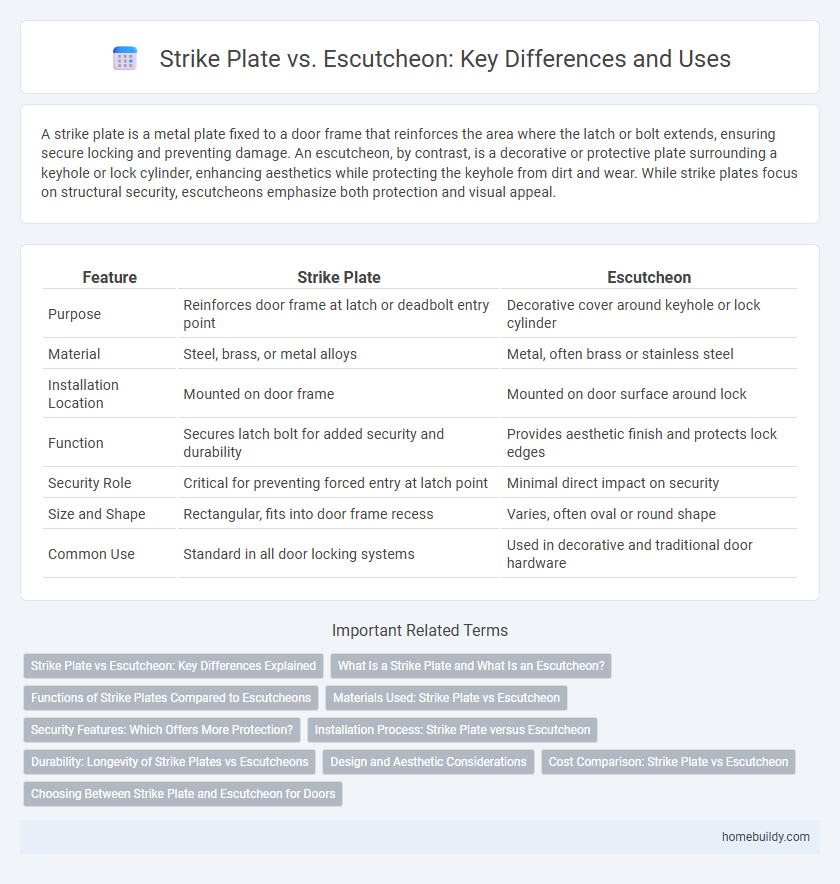A strike plate is a metal plate fixed to a door frame that reinforces the area where the latch or bolt extends, ensuring secure locking and preventing damage. An escutcheon, by contrast, is a decorative or protective plate surrounding a keyhole or lock cylinder, enhancing aesthetics while protecting the keyhole from dirt and wear. While strike plates focus on structural security, escutcheons emphasize both protection and visual appeal.
Table of Comparison
| Feature | Strike Plate | Escutcheon |
|---|---|---|
| Purpose | Reinforces door frame at latch or deadbolt entry point | Decorative cover around keyhole or lock cylinder |
| Material | Steel, brass, or metal alloys | Metal, often brass or stainless steel |
| Installation Location | Mounted on door frame | Mounted on door surface around lock |
| Function | Secures latch bolt for added security and durability | Provides aesthetic finish and protects lock edges |
| Security Role | Critical for preventing forced entry at latch point | Minimal direct impact on security |
| Size and Shape | Rectangular, fits into door frame recess | Varies, often oval or round shape |
| Common Use | Standard in all door locking systems | Used in decorative and traditional door hardware |
Strike Plate vs Escutcheon: Key Differences Explained
Strike plates and escutcheons serve distinct functions in door hardware systems, with strike plates designed to reinforce the door frame and receive the latch or bolt, enhancing security and durability. Escutcheons primarily provide a decorative cover around keyholes or lock cylinders, protecting the lock mechanism while improving aesthetic appeal. Key differences include strike plates focusing on structural reinforcement and security, whereas escutcheons emphasize visual finish and minor protection.
What Is a Strike Plate and What Is an Escutcheon?
A strike plate is a metal plate installed on a door frame that reinforces the latch or bolt hole, providing a secure surface for the door lock to engage. An escutcheon, by contrast, is a decorative or protective plate surrounding a keyhole or lock cylinder on a door, often enhancing aesthetic appeal and preventing wear. While the strike plate focuses on security and structural reinforcement, the escutcheon primarily serves as an ornamental cover and shield for lock components.
Functions of Strike Plates Compared to Escutcheons
Strike plates serve as the crucial metal reinforcement on door frames, securing the latch or bolt in place and ensuring proper locking functionality. Escutcheons primarily provide aesthetic cover for keyholes or locking mechanisms, protecting against tampering but not directly contributing to the door's locking strength. The strike plate's function is structural and security-focused, while escutcheons emphasize decorative protection and key access.
Materials Used: Strike Plate vs Escutcheon
Strike plates are typically made from durable metals like stainless steel, brass, or zinc alloys to withstand repeated impact and ensure door security. Escutcheons often use similar materials but can include decorative finishes such as chrome, nickel, or bronze to enhance aesthetic appeal while protecting keyholes or lock cylinders. The main material difference lies in the strike plate's emphasis on strength and resistance, whereas escutcheons balance durability with ornamental design.
Security Features: Which Offers More Protection?
Strike plates provide a crucial layer of security by reinforcing the door frame where the latch or deadbolt engages, often constructed from heavy-duty steel to resist forced entry. Escutcheons primarily serve as protective covers around keyholes, preventing tampering and drilling, but they do not reinforce the door frame itself. When comparing security features, strike plates offer more substantial protection against break-ins due to their structural role in door strength and resistance to kick-ins.
Installation Process: Strike Plate versus Escutcheon
The installation process of a strike plate involves mortising the door frame to ensure a flush fit, providing secure reinforcement for the latch or bolt. In contrast, installing an escutcheon requires mounting the decorative plate around a lock or handle, often involving screw fittings to cover keyholes or mechanisms without structural modifications. Strike plates focus on functional alignment with door hardware, while escutcheons emphasize aesthetic enhancement and protection.
Durability: Longevity of Strike Plates vs Escutcheons
Strike plates are typically made from hardened steel, offering superior resistance to wear and impact forces compared to escutcheons, which are often crafted from thinner metal or decorative materials. Their robust construction ensures enhanced durability and a longer lifespan, particularly in high-traffic areas where door security is critical. Escutcheons primarily serve aesthetic purposes and minimal protection, resulting in significantly less longevity under frequent use or force.
Design and Aesthetic Considerations
Strike plates feature a functional, minimalist design primarily aimed at reinforcing door latches, often crafted from durable metals like brass or stainless steel to ensure longevity. Escutcheons, by contrast, emphasize decorative appeal, offering ornate patterns and varied finishes that enhance door aesthetics while surrounding keyholes or handles. When selecting between the two, consider that strike plates prioritize security and durability whereas escutcheons contribute significantly to the visual style and architectural detail of doors.
Cost Comparison: Strike Plate vs Escutcheon
Strike plates generally cost less than escutcheons due to their simpler design and primary function of reinforcing door frames. Escutcheons, often decorative and protective for keyholes or locks, typically have higher manufacturing and material expenses. Choosing between the two depends on budget considerations and the desired balance between functionality and aesthetic appeal.
Choosing Between Strike Plate and Escutcheon for Doors
Strike plates reinforce door frames by securing the latch bolt, providing enhanced security and durability against forced entry. Escutcheons primarily protect the keyhole or lock cylinder area, adding decorative appeal while shielding the lock mechanism from tampering and wear. Selecting between a strike plate and an escutcheon depends on whether the primary need is structural reinforcement or aesthetic and functional lock protection for the door.
Strike plate vs escutcheon Infographic

 homebuildy.com
homebuildy.com